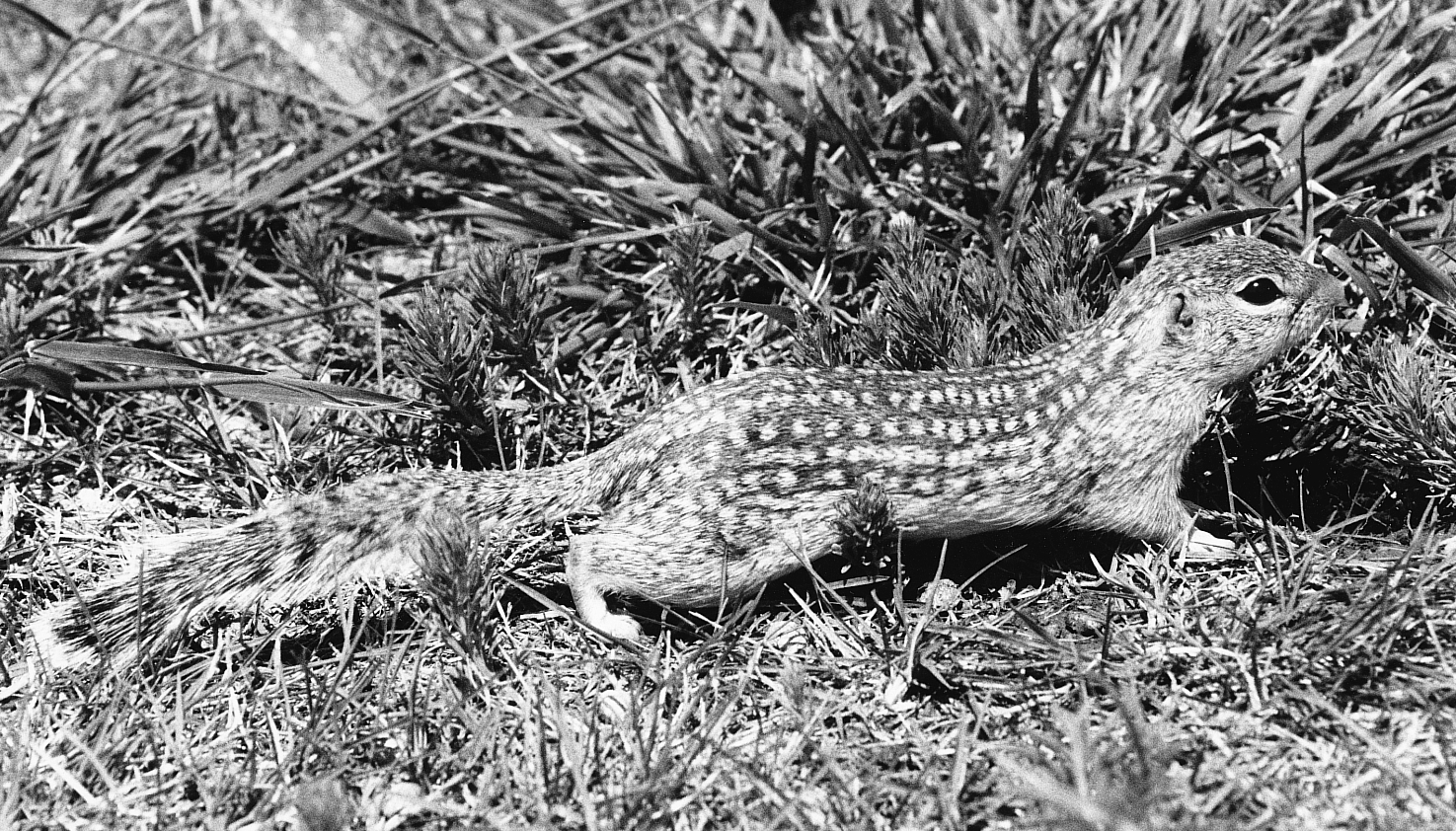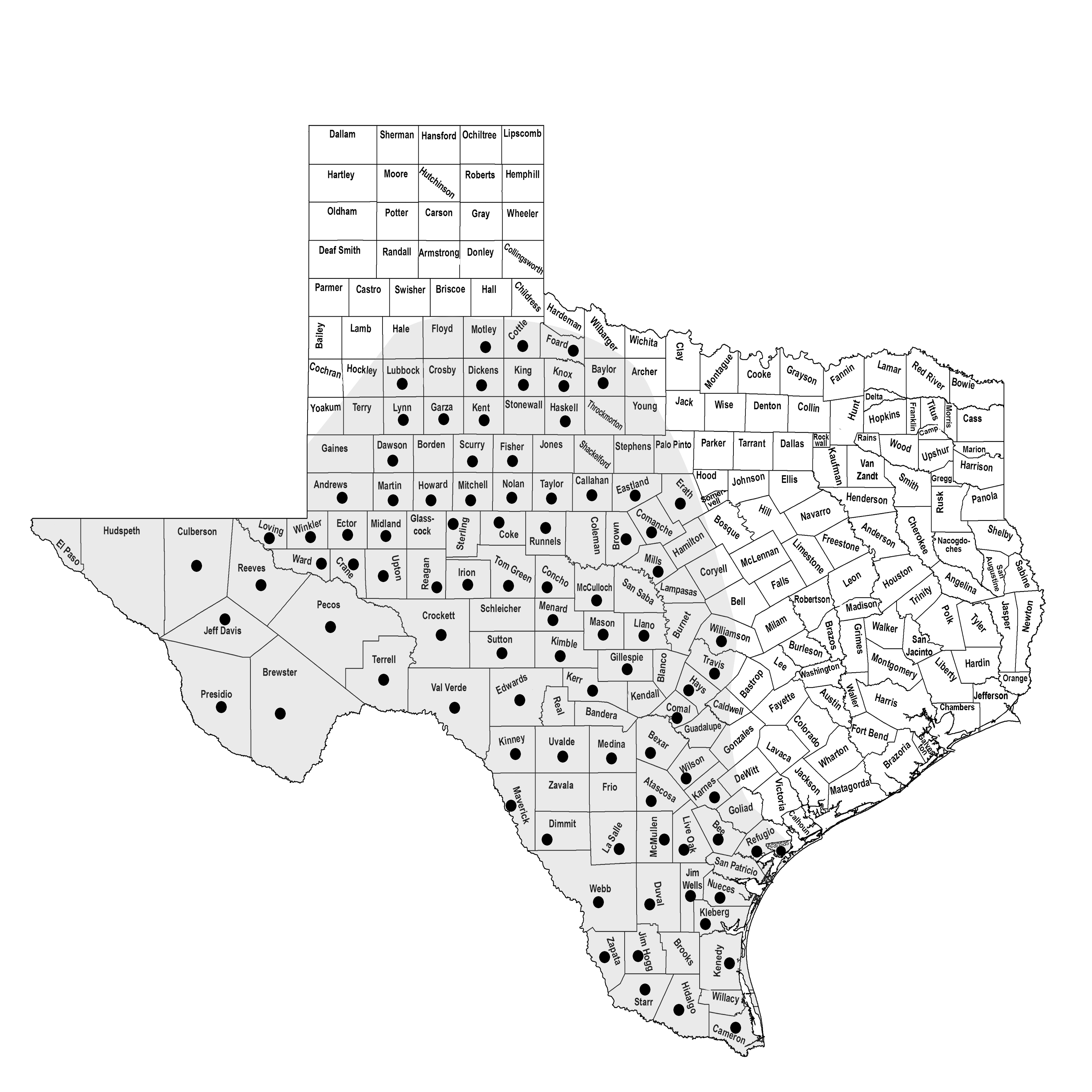RIO GRANDE GROUND SQUIRREL
Ictidomys parvidens (Mearns 1896)
Order Rodentia : Family Sciuridae
DESCRIPTION. A rather small ground squirrel (previously treated as Spermophilus mexicanus; see "Remarks") with usually nine rows of squarish white spots on back; tail about two-fifths of total length, moderately bushy; ears short and rounded; upperparts wood brown or buffy brown with rows of conspicuous white spots; sides and underparts whitish or pinkish buff. Dental formula: I 1/1, C 0/0, Pm 2/1, M 3/3 × 2 = 22. Averages for external measurements: total length, 301 mm; tail, 118 mm; hind foot, 41 mm. Weight of males, 227–330 g; of females, 137–198 g.

DISTRIBUTION. Occurs throughout much of southern and western Texas (west to Culberson, Jeff Davis, and Presidio counties and possibly into Hudspeth and El Paso counties in the Trans-Pecos), north almost to the Red River just east of the Panhandle, and east to Erath and Travis counties.

SUBSPECIES. Monotypic species.
HABITS. Rio Grande ground squirrels inhabit brushy or grassy areas. In southern Texas they are frequently associated with mesquite and cactus flats. In Kerr County they are most common in pastures and along the highways. In the Trans-Pecos they are frequently found in areas dominated by creosote bush (Larrea). On the Llano Estacado they are associated with mesquite pastures and various other brush and cacti but also occur on golf courses, in cemeteries and city parks, and along highway right-of-ways. On the Edwards Plateau they favor areas mowed and maintained by humans and seem to thrive in overgrazed pasturelands.
They live in burrows, the openings to which are usually unmarked by a mound of earth. Sandy or gravelly soils are preferred, but the squirrels are by no means restricted to them. One squirrel may utilize several burrows, one of which is the homesite; the others are temporary refuges. The burrows are typically 6–8 cm in diameter, enter the ground at a 30°–50° angle, and range from 30 to 125 cm below the surface. The brood chamber is usually at the deepest part in a side tunnel. There are often two openings to the burrow system, possibly to facilitate escape. They also utilize burrows of pocket gophers. Although somewhat colonial, they are rather unsocial and drive away other squirrels that intrude on their privacy. Their home range is about 45 m (148 ft.) in radius.
Near Midland most of the Rio Grande ground squirrels are in hibernation by 20 November, although there is some activity throughout the winter. Likewise, in the Trans-Pecos they occasionally are seen in winter, but in South Texas they remain active throughout the year.
Their food in early spring is chiefly green vegetation. They are known to feed on mesquite leaves and beans, agarita leaves and berries, Shasta lily, Johnsongrass, pin clover, and cultivated grains. Insects are also important in their diet. In early summer about half of their diet is insects. They often capture and eat lizards and occasionally can be seen feeding upon small animals killed on the highways. In captivity they exhibit a cannibalistic behavior and kill and eat their cage mates, particularly if a strange squirrel is placed with them. Occasionally they climb into low bushes to forage, but most of their food is gathered on the ground.
Breeding begins in late March or early April and lasts for 1–2 weeks. The gestation period is probably not >30 days. Females captured in the month of May from the Edwards Plateau carried 2–10 embryos, with the most common number being 6. The young are born blind and almost naked and weigh 3–5 g.
POPULATION STATUS. Common. The Rio Grande ground squirrel remains in good shape throughout its range in Texas, and it is the most common ground squirrel residing on the Edwards Plateau. Fred Stangl (Midwestern State University), Cody Thompson, and RDB have shown that this species may be increasing its range in Texas.
CONSERVATION STATUS. The IUCN recognizes the Rio Grande ground squirrel as Spermophilus mexicanus and lists it as a species of least concern. It does not appear on the federal or state lists of concerned species. No conservation efforts are needed.
REMARKS. Formerly included as Spermophilus mexicanus, a 2009 taxonomic revision by Chris Helgen and colleagues (Smithsonian Institution) necessitated placement of the Rio Grande ground squirrel into the genus Ictidomys.
In 2013, Fred Stangl (Midwestern State University), Cody Thompson, and RDB demonstrated that the Rio Grande ground squirrel hybridizes with I. tridecemlineatus along their parapatric distribution (Hobbs, New Mexico, to near Wichita Falls, Texas). Ictidomys tridecemlineatus reaches the limit of its geographic distribution in broad contact with the Rio Grande ground squirrel on the southern Llano Estacado. Ictidomys tridecemlineatus is a species of the Great Plains, whereas I. parvidens is a species of desert grasslands, but competitive interaction has not been documented other than the supposed areas of hybridization. Hybridization may affect long-term genetic purity of populations in north-central Texas; consequently, these latter populations need to be monitored carefully.
From The Mammals of Texas, Seventh Edition by David J. Schmidly and Robert D. Bradley, copyright © 1994, 2004, 2016. Courtesy of the University of Texas Press.
Natural Science Research Laboratory
-
Address
Museum of Texas Tech University, 3301 4th street, Lubbock, TX 79409 -
Phone
806.742.2486 -
Email
nsrl.museum@ttu.edu

